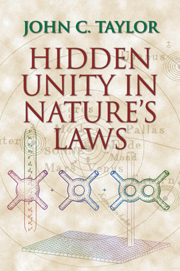Book contents
- Frontmatter
- Contents
- Preface
- 1 Motion on Earth and in the Heavens
- 2 Energy, Heat and Chance
- 3 Electricity and Magnetism
- 4 Light
- 5 Space and Time
- 6 Least Action
- 7 Gravitation and Curved Spacetime
- 8 The Quantum Revolution
- 9 Quantum Theory with Special Relativity
- 10 Order Breaks Symmetry
- 11 Quarks and What Holds Them Together
- 12 Unifying Weak Forces with QED
- 13 Gravitation Plus Quantum Theory – Stars and Black Holes
- 14 Particles, Symmetries and the Universe
- 15 Queries
- APPENDIX A The Inverse-Square Law
- APPENDIX B Vectors and Complex Numbers
- APPENDIX C Brownian Motion
- APPENDIX D Units
- Glossary
- Bibliography
- Index
4 - Light
Published online by Cambridge University Press: 20 January 2010
- Frontmatter
- Contents
- Preface
- 1 Motion on Earth and in the Heavens
- 2 Energy, Heat and Chance
- 3 Electricity and Magnetism
- 4 Light
- 5 Space and Time
- 6 Least Action
- 7 Gravitation and Curved Spacetime
- 8 The Quantum Revolution
- 9 Quantum Theory with Special Relativity
- 10 Order Breaks Symmetry
- 11 Quarks and What Holds Them Together
- 12 Unifying Weak Forces with QED
- 13 Gravitation Plus Quantum Theory – Stars and Black Holes
- 14 Particles, Symmetries and the Universe
- 15 Queries
- APPENDIX A The Inverse-Square Law
- APPENDIX B Vectors and Complex Numbers
- APPENDIX C Brownian Motion
- APPENDIX D Units
- Glossary
- Bibliography
- Index
Summary
How light is a wave-like electromagnetic field.
Waves
This chapter is about the nature of light. Section 4.8 describes one of the great unifications of physics: the demonstration that light is just part of electricity and magnetism.
The first thing to be explained is the wave nature of light, so I begin by saying what is meant by a wave. We are all familiar with water waves, but I will define a wave in a general way.
In a wave, a shape propagates over a long distance, but matter (or whatever the wave is “in”) moves only locally. For example, if a stone is dropped into the middle of a sizeable pond, waves may be propagated to the edge of the pond. But the actual water is only moving locally. For example, the surface goes up and down.
We need to define one or two terms. The simplest sort of wave is what is called a simple harmonic wave (the name comes from the connection with musical notes). Here the shape is like that of a corrugated surface. To define it mathematically, we can imagine doing the following. (See Figure 4.1.)
Take a wheel with a peg on its side. Take a vertical pen with a slot in its stem and with the peg in the slot. Let the wheel rotate at a steady rate, so that the pen is moved from side to side (remaining always vertical). Let the nib of the pen rest on a long sheet of paper (under the wheel), which is being pulled at a constant speed in the direction of the wheel's axis.
Information
- Type
- Chapter
- Information
- Hidden Unity in Nature's Laws , pp. 99 - 136Publisher: Cambridge University PressPrint publication year: 2001
